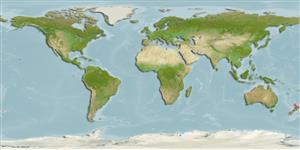>
Blenniiformes (Blennies) >
Tripterygiidae (Triplefin blennies) > Tripterygiinae
Etymology: Notoclinops: Greek, noton = back + Greek, klinein, kline = sloping and also bed, due to the four apophyses of sphenoid bone + Greek, ops = appearance (Ref. 45335).
Environment: milieu / climate zone / depth range / distribution range
Ecología
marino demersal; rango de profundidad 0 - 40 m (Ref. 9003). Temperate
Southwest Pacific: New Zealand.
Tamaño / Peso / Age
Maturity: Lm ? range ? - ? cm
Max length : 3.6 cm SL macho / no sexado; (Ref. 13227)
Short description
Morfología | Morfometría
Espinas dorsales (total): 21 - 23; Radios blandos dorsales (total): 10-13; Espinas anales 1; Radios blandos anales: 23 - 25. Head mauve with bright orange patches. Eyes with a fine bright blue line around pupils. Body with 9-10 orange to blackish dorsal bands on the posterior half. Distinguished from other triplefins by the distinctive color pattern. Pelvic fins reduced to 2 rays.
Adults occur in tidal pools and the subtidal zone, usually on encrusted walls and other overhangs. They remove parasites from large fishes such as moray eels (Ref. 13227). Eggs are hemispherical and covered with numerous sticky threads that anchor them in the algae on the nesting sites (Ref. 240). Larvae are planktonic which occur primarily in shallow, nearshore waters (Ref. 94114).
Life cycle and mating behavior
Madurez | Reproducción | Puesta | Huevos | Fecundidad | Larva
Fricke, R., 1994. Tripterygiid fishes of Australia, New Zealand and the southwest Pacific Ocean (Teleostei). Theses Zool. 24:1-585. (Ref. 13227)
IUCN Red List Status (Ref. 130435)
Threat to humans
Harmless
Human uses
Más información
Age/SizeCrecimientoLength-weightLength-lengthLength-frequenciesMorfometríaMorfologíaLarvaDinámica larvariaReclutamientoAbundanciaBRUVS
ReferenciasAcuiculturaPerfil de acuiculturaRazasGenéticaElectrophoresesheritabilidadEnfermedadesProcesamientoNutrientsMass conversion
ColaboradoresImágenesStamps, Coins Misc.SonidosCiguateraVelocidadTipo de nataciónSuperficie branquialOtolitosCerebrosVisión
Herramientas
Special reports
Download XML
Fuentes de Internet
Estimates based on models
Preferred temperature (Ref.
123201): 13.6 - 22.3, mean 18.2 °C (based on 30 cells).
Phylogenetic diversity index (Ref.
82804): PD
50 = 0.6250 [Uniqueness, from 0.5 = low to 2.0 = high].
Bayesian length-weight: a=0.00562 (0.00258 - 0.01228), b=3.08 (2.89 - 3.27), in cm total length, based on LWR estimates for this (Sub)family-body shape (Ref.
93245).
Nivel trófico (Ref.
69278): 3.1 ±0.3 se; based on size and trophs of closest relatives
Resiliencia (Ref.
120179): Alto, población duplicada en un tiempo mínimo inferior a 15 meses (Preliminary K or Fecundity.).
Fishing Vulnerability (Ref.
59153): Low vulnerability (10 of 100).
Nutrients (Ref.
124155): Calcium = 387 [170, 1,915] mg/100g; Iron = 1.47 [0.57, 3.79] mg/100g; Protein = 17.6 [15.8, 19.3] %; Omega3 = 0.459 [0.109, 1.913] g/100g; Selenium = 24.1 [4.7, 100.8] μg/100g; VitaminA = 8.22 [0.95, 66.24] μg/100g; Zinc = 2.61 [1.19, 5.15] mg/100g (wet weight);
